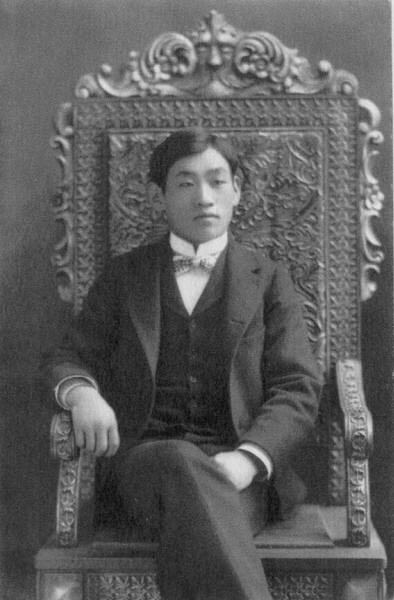|
This newsletter gives the photographer's full name as Tsunekicki
Imai. It is the story of Ted Imai, son of the photographer,
but it also provides us background information on T. Imai...
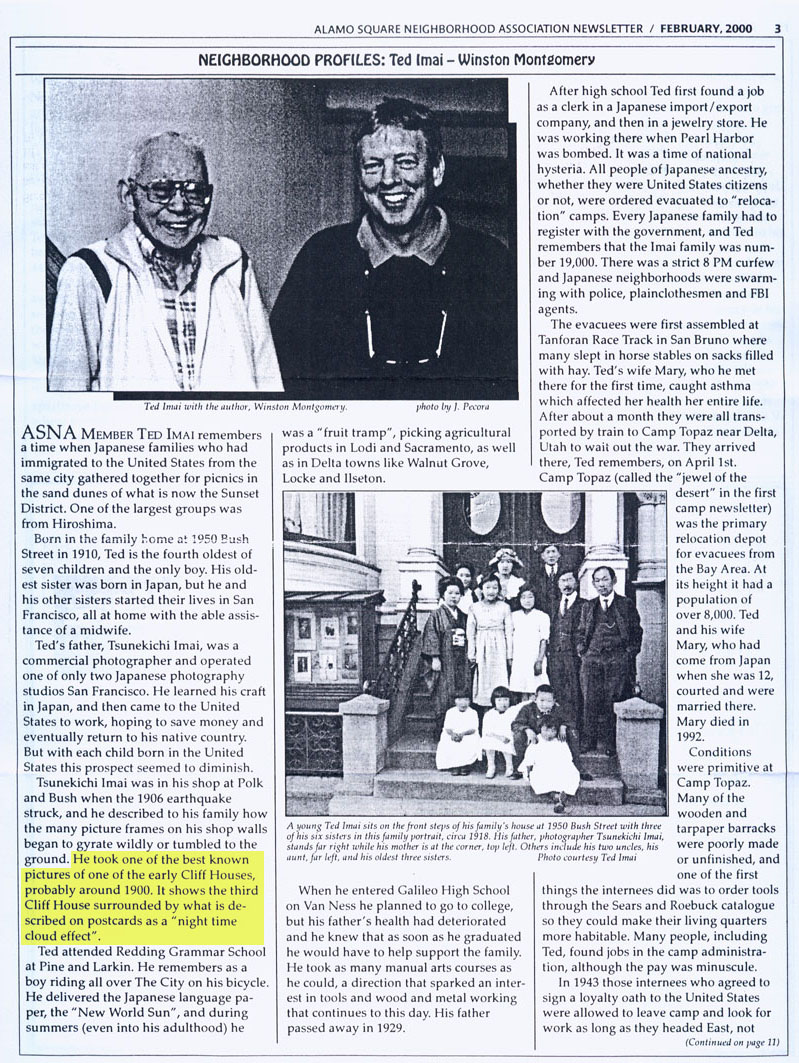
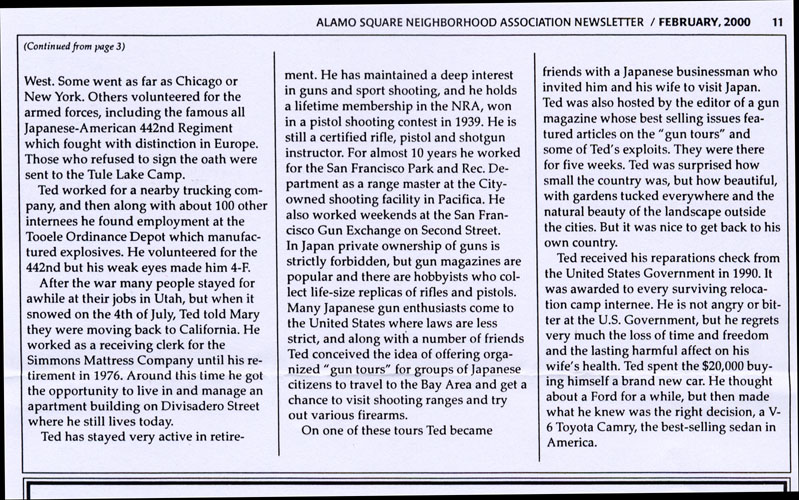
Forward:
The vast majority of the information in this article
comes from Ted Imai, now 95, the photographer’s only son. Like most
memories from long ago, Ted’s are sometimes indistinct, disjointed
and even contradictory, and they may derive from family tradition,
not fact. I did some research at San Francisco’s Japanese American
History Archives with the assistance of Mr. Seizo Oka, community
historian and executive director of the archives (recently diseased)
and at the S.F. Public Library. I intend in the future to consult
with other members of the Imai family who may have more or different
information, and I would also like to try to find experts in
historic photography to take a in depth look at the “Night Time
Cloud Effect” photo. So this is a work in progress.
Tsunekichi Imai
Tsunekichi Imai, who created what is probably the best known
photographic image of the third Cliff House (1896-1907), was
according to his family and other sources, the first Japanese
commercial photographer in San Francisco. He operated a studio at
1303 Polk Street, near Bush, (cited in the Japanese Yearbook of
1905) and later at 1950 Bush Street, which also served for many
years as the Imai family home.
Born in 1872 in Yamaguchi, an agricultural region on
the island of Honshu in southern Japan, he learned his craft in his
native country and then in 1899 immigrated to United States.
Economic conditions in Japan were difficult, and Tsunekichi Imai was
part of large wave of workers who were drawn to California because
of an acute labor shortage caused by the imposition of the Chinese
Exclusion Act which had cut off the supply of immigrant Chinese
workers. He may have thought that a burgeoning Japanese community
would be well served by its own photographer.
Originally Tsunekichi Imai planned to save the money he
made and return to Japan, but with each child born in the United
States this prospect seemed to grow dimmer. He and his wife, Taki,
eventually had seven girls and one boy. Ted (originally Heiyu) Imai,
born in 1910, is the second oldest child and the first to be born in
the United States. One daughter died at about seven years of age
from acute appendicitis.
Tsunekichi Imai was working in his Polk Street studio
when the 1906 earthquake struck, and he described to his family how
the pictures hanging from his shop walls shook and gyrated wildly,
many tumbling to the ground. In the days that followed, the rapidly
spreading fire which followed the quake overwhelmed firefighters and
threatened to destroy the entire city. To stop the fire by depriving
it of fuel, officials decided to create a firebreak by dynamiting a
swath of buildings east of Van Ness Avenue. The Imai studio was
located in one of these buildings.
The structures to be exploded were evacuated hurriedly
and Tsunekichi Imai thought that all his equipment and furniture had
been lost. Someone suggested that he go up to Lafayette Park at
Washington and Laguna streets, and there he discovered stacks of
personal possessions and household furnishings covered by tarpaulins
that firemen and other volunteers must have rescued from the doomed
buildings. He found most of the things from his shop piled together
and even labeled with his name. Ironically many of the photographs
and other personal affects that survived the earthquake and fire
were lost during the period that the Imai family was interned during
W.W. II at Camp Topaz in Utah.
Tsunekichi Imai took a number of photographs in the
earthquake’s aftermath, the most notable, according to his son, Ted,
showed a man trapped on the upper balcony of a burning building
pleading for help as the flames engulfed him. The picture was taken
just as soldiers on the ground shot the man with their rifles to put
him out of his misery. Ted says his father was fearful of the
possible legal implications of taking this photo or even witnessing
this event, and eventually destroyed it.
Ted, who as a young boy often acted as his father’s
assistant, has a vivid memory of other photographs his father took.
When the 1918 influenza epidemic struck San Francisco (doing
particular damage in the Japanese community) his father was busy
around the clock taking photographs of the victims to send back to
their relatives in Japan. The Japanese in San Francisco were served
chiefly by the Martin and Brown Funeral Home on Sutter St. One
particularly poignant image Ted recalls was of a mother with her
infant in her arms, both sharing the same coffin.
Tsunekichi Imai also was commissioned to do a photographic portrait
of the colorful early California literary figure, Joaquin Miller,
the so-called “poet of the Sierras”. A friend of Jack London and
Ambrose Bierce, Joaquin Miller in his later years was a resident of
the Oakland Hills and his forested 75 acre estate which he called
“The Hights” is now a park. Ted Imai believes an original print of
this photo is still in the possession of the Imai family.
Another portrait of a dignitary that Tsunekichi Imai crafted was of
Prince Fushimi (Hiroyasu), a member of the Japanese Imperial Family.
The City of San Francisco has always had a close relationship with
Japan, --the first visit of a Japanese warship to San Francisco was
in 1860, and the tradition of naval visits to San Francisco
continued until the First World War.
Every two years the Japanese Training Squadron on their
Sea Cadet graduation cruise would lay anchor in San Francisco. Like
this era’s Fleet Week, the ships, mostly old battleships, were open
to the public, and in San Francisco and the East Bay there were
welcoming ceremonies and exhibitions of Japanese arts and culture
including sumo wrestling, martial arts and fencing. The ships gave
away small Japanese flags and other souvenirs. Ted Imai, like all
Japanese American kids, was tremendously excited. The culmination of
the events was a huge parade down Market Street in San Francisco.
Tsunekichi Imai took photos of many of these events and
he was invited to attend the banquet in honor of the Japanese guests
which was sponsored by the Japanese American Association. This was
held at some of San Francisco’s most prestigious hotels including
the Fairmount and the St. Francis. Tsunekichi Imai always sat at a
table with the teenage cadets and their training officers and since
they had not traveled much out of their country or had much
familiarity with western cuisine they looked to him for clues as how
to behave. There was a bowl of olives on every table and throughout
the meal there was much discussion as to their nature and purpose.
As the table was being cleared and coffee served, Tsunekichi Imai
grabbed a handful of olives and dropped them into his cup. All the
Japanese cadets and officers immediately followed suit.
It was probably in 1904 that Tsunekichi Imai took the
portrait of Prince Fushimi, an Admiral in the Japanese Navy, a
member of the Japanese Supreme War Council and Chief of the Japanese
Naval General Staff from 1932 to 1941. At the Japanese American
History Archives in San Francisco there is a picture of the Prince
on a visit to San Francisco in 1904. In gratitude for the portrait
Prince Fushimi gave the photographer a silver cloisonné cigarette
case and a sterling silver matchbox. These gifts are still in
possession of the Imai family.
After the Japanese attack on Pearl Harbor, the Imai
family, afraid that their loyalty to the United States would be
questioned if this portrait were discovered in their home,
transported the original print to the Japanese Consulate in San
Francisco, from which it disappeared.
According to Ted Imai, the most interesting fact about his father’s
photograph of the Cliff House, sometimes called “Nighttime Cloud
Effect” is that it was essentially a fake, created or at least
substantially enhanced in the studio. Ted was not born until after
the picture was taken, but his father over the years told him that
he had shot the photo in broad daylight and then gradually darkened
it over a period of 4 or 5 days, retouching it and redeveloping it
by trial and error until he had achieved the desired image. Ted does
not remember the specific processes or chemicals his father used. In
support of this theory Ted says that such an exposure would have
been impossible to create with the primitive cameras of the time and
flash powder, the only supplemental illumination then available to
photographers.
Ted remembers that his father had a very well equipped
studio for his time, including a custom built 4 ft by 4 ft enlarger
he utilized to print his portraits. It featured a 1000 watt light,
immensely powerful for its time.
Some observers see a bolt of lightning in the photograph, but upon
closer examination it appears to be the edge of a backlit cloud. I
have no reason to doubt Ted Imai’s memory but at least one
knowledgeable photographer says it appears authentic. In reply to my
inquiry, Haral Edens, a doctoral candidate in atmospheric psychics
at the New Mexico Institute of Mining and Technology, an experienced
weather photographer and proprietor of
www.weather-photography.com states as follows:
“I’m almost sure that that photo is real. There is no lightning
in the photo however; the streak of light going to the upper left is
a so-called silver lining effect. You can also see the shadow of
that cloud to its right, cast on another cloud (the sun must have
been left of the photo). No-one would produce that shadow effect in
a studio, since it is little interesting. I think that that gives a
clue that the scenery has not been edited or created.”
Obviously more investigation on how this photo was
created remains to be done, but it is possible that a daytime photo
containing an unusual configuration of light and cloud was
strategically darkened to make it appear that it was taken at night.
The lights or reflections of light in the lower windows of the Cliff
House probably would be relatively easy to add.
Some of the existing prints of “Nighttime Cloud Effect”
have “Imai” written in ink diagonally across the right hand corner.
From 1985 a version of this photograph without “Imai” has been
featured on the cover of Marilyn Blaisdell’s “San Francisciana:
Photographs of the Cliff House”. Originally the photographer was
unnamed but the Imai family was able to prevail upon the publisher
to add T. Imai to the list of credits. There is another photograph
in that book, “Tea House and Lunch Stand, Cliff House Terrace” (page
49) which Ted Imai remembers his father taking. In fact he remembers
acting as his father’s helper that day and carrying the photo plates
in a leather case.
As to the small, cardboard framed souvenir version of
the photo which features on the reverse side the fanciful, but
racially stereotyped description of how the photo was taken, my copy
of that photo features the ink stamp of the store which most likely
sold it.
|
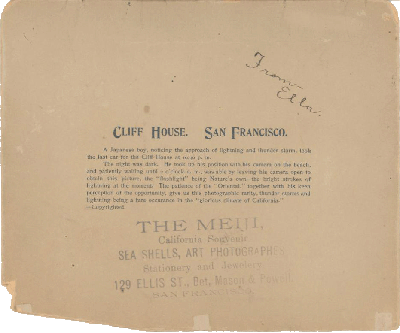 |
This was an obviously Japanese store and was listed in the San
Francisco City Directory beginning in 1901 and ending, ominously, in
1941. The fact that the photo was sold in a Japanese store and that
the account of its origin contains an element of truth and supports
the reported fiction of its night time creation leads me to believe
that the caption was written with the assent and knowledge of the
photographer. Tsunekichi Imai and the retailers he used probably
thought that a sympathetic and inspirational story would make the
photo more saleable.
Ted Imai says (and the story about the olives
reinforces this) that his father was an inveterate practical joker
so this mythical story behind the photo probably appealed to him
greatly. However, he was not fluent in English, and someone else
would have had to do the actual composition.
Tsunekichi Imai was a creative man of many talents and artistic
interests. He was formally trained in Japan in flower arrangement
and he was a bonsai enthusiast and avid gardener. In the backyard of
the family home at 1950 Bush he designed and built a traditional
style Japanese Tea Garden with a ornamental fish pond and a tea
house custom built by a local Japanese carpenter featuring finely
crafted sliding shoji doors.
Tsunekichi Imai visited Yosemite often with his family
and he came to admire highly an interestingly shaped boulder in the
park. When his tea garden neared completion he recruited a friend
who worked at Pacific Laundry and they drove the company’s Model T
panel truck to Yosemite and brought the four or five hundred pound
stone back with them. When the Imai’s moved from 1950 Bush a
neighbor moved it to his own yard.
Tsunekichi Imai died in 1929.
Winston Montgomery
Addendum: Ted’s Photos Returned
There is another interesting story concerning the
history of the Imai family and photographs taken by Tsunekichi Imai.
Soon after I visited the Japanese American History Archive a few
years ago, I was contacted by Kimi Wood, a San Francisco native
living in Redwood City. She had visited the Archives to try to find
out if anyone with the surname Imai was still living in San
Francisco. They would have to be quite elderly by this time, she
thought. She was in possession of some old glass plates and photo
albums that were marked with the name Imai.
Kimi’s parents had lived in Japan for a number of years
after the Second World War where her father was in the U.S. Armed
Forces and her mother had taught English to Japanese women. During
their stay in Japan they developed a tremendous affection and
respect for the Japanese people and culture, hence their daughter
Kimi’s name. Back in the United States in the late 1960’s some
friends were renting an apartment at 2025 Pine Street near Japantown
and discovered a cache old photos concealed in a joist space in the
garage. They turned them over to Kimi’s mother because they knew of
her strong interest in Japan.
Over 30 years later when Kimi was helping her mother
pack up her possessions to move she came across the photographs and
decided to see if she could locate their owners. Kimi had done
genealogical research before, including working on the Mormon lists.
One of her first investigative forays was to the Japanese American
History Archives where Mr. Oka told her that someone else had just
been in seeking information about the Imai family. Ted and Kimi were
introduced and his family photos returned to him. Ted remembered
them specifically (in fact they were mostly of him as a child since
as the only boy and highly photogenic he was his father’s favorite
subject. Ted’s description of why they were hidden in the garage
gives a vivid picture of the chaotic and desperate days before the
Japanese were forced to get on buses and leave San Francisco. Since
they could take very little to the internment camps, families faced
the problem of what do with their personal possessions. Warehouses
and furniture storage facilities filled up quickly and many families
were left with no way to protect their furniture and personal items.
Some unscrupulous people took advantage of this situation by going
from house to house in Japantown offering to buy people’s furniture
for pennies on the dollar, Ted remembers, and some of the Japanese
got as much as they could for their stuff, but others attempted to
conceal things in their house or on their property. Most items were
never seen again.
Ted tells of entire automobiles being buried in
backyards, tools and other valuables hidden under floorboards and
personal possessions crammed in crawlspaces or behind attic rafters.
Ted Imai hid some of his machine tools under the floor in his
basement, but they were gone when he returned. This is how the
photos ended up concealed in the garage at 2025 Pine Street, the
house that the Imai family moved to sometime in the 1930’s (they
were renters) when 1950 Bush Street was sold to a local Japanese
doctor.
Winston Montgomery, a
longtime San Francisco resident, is a retired painting and
plastering contractor who is re-inventing himself as a songwriter.
You can listen to his songs at
www.wmontgomerysongs.com or send him an email at
winpegg@att.net.
|
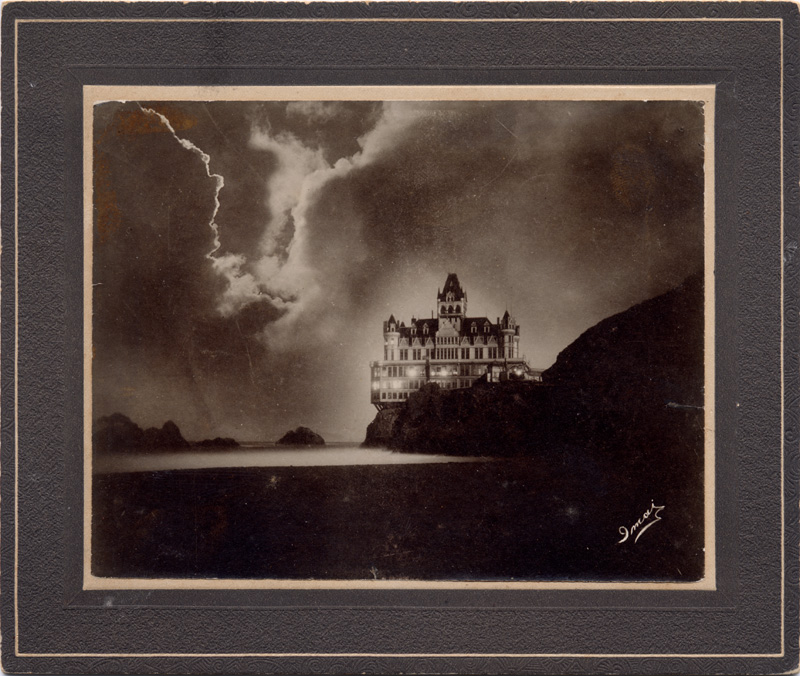
.jpg)
.jpg)
